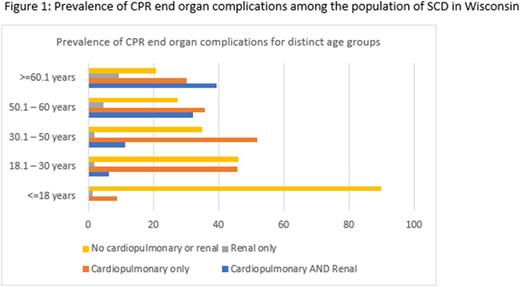Abstract
Introduction: Individuals with SCD are at risk of developing numerous chronic complications including cardiopulmonary and renal (CPR) end organ complications, which are associated with early mortality. However, there is limited knowledge regarding the proportion of individuals with SCD who have CPR end organ complications and the acute care utilization of this subset of patients. The objective of this study was to determine the prevalence of CPR end organ complications in a state specific SCD population and compare acute care utilization among SCD individuals who have CPR end organ complications with those who do not.
Methods: We leveraged the Sickle Cell Data Collection Program in Wisconsin, which includes linked data from Medicaid and electronic health records from two large tertiary care facilities in the state for years 2018 - 2020. Individuals were considered to have SCD if they had more than two visits or claims with an associated diagnosis code of SCD. Individuals with SCD were considered to have cardiopulmonary complications if they had a visit or claim with a diagnosis code for cardiomyopathy, dysrhythmia, pulmonary heart disease, heart failure, Long QT syndrome, and/or pulmonary fibrosis. Renal complications included chronic kidney disease, proteinuria and/or hematuria. The prevalence was determined as the proportion of people with CPR end organ complications. The prevalence between distinct age groups and sex was compared using chi square tests. The number of acute care visits (including ED treat and release and hospitalizations) were compared between SCD individuals with and without CPR end organ complications using generalized linear models assuming negative binomial distribution adjusted for age. We also conducted pairwise comparisons to determine if there were differences in acute care utilization between individuals who had no CPR end organ complications and those who had both cardiopulmonary and renal, cardiopulmonary only, and renal only respectively. All pairwise comparisons were adjusted for age and multiple comparisons using false discovery rates. P-value of <0.05 was considered significant.
Results: Our study included 1095 individuals with SCD in Wisconsin (mean age (SD) = 26.4 (17.5) years and 54% females). There were 423 children (≤18 years of age) included in the cohort, of which 10.1% had at least one CPR end organ complication. There were 672 adults, and the prevalence of CPR end organ complications was significantly higher in adults as compared to children (63.2% vs 10.1%, p value <0.001). The distribution of CPR end organ complications by age is shown in Figure 1. There was no difference in prevalence of CPR end organ complications by sex (p value = 0.62). Overall, there were a median of 5 (IQR: 2- 11) acute care visits in the entire cohort during the 3 year study period. The number of acute care visits among individuals with SCD and CPR end organ complications was significantly higher than for those who did not have CPR end organ complications (median 9 (IQR: 3 - 19) vs 4(1-7), age adjusted p-value <0.0001). The pairwise comparisons showed that the number of acute care visits was significantly higher among SCD individuals who had cardiopulmonary complications (median 9 (IQR: 4 - 20)) or cardiopulmonary and renal complications (median 9 (IQR: 4 - 25)) compared to those who did not have any CPR end organ complications (median 5 (IQR: 1 -7), p-value = 0.001). However, there was no significant difference in acute care visits between SCD individuals with renal complications and those with no CPR end organ complications (p = 0.61). The number of acute care visits for those who had only cardiopulmonary complications was also significantly higher than those who had only renal end organ complications (median 9 (IQR: 3 - 20 vs median 4 (1 - 10), p-value = 0.001).
Conclusions: The data from the SCD surveillance program in WI show that a majority of adults with SCD have CPR end organ complications. Acute care utilization is specifically higher for individuals with SCD who have cardiopulmonary complications, suggesting that further studies are needed to understand the reasons for their acute care visits. Prevention or treatment of CPR end organ complications might decrease the high number of acute care visits in a subset of the SCD population.
Disclosures
Brousseau:CSL Behring: Consultancy.
Author notes
Asterisk with author names denotes non-ASH members.


This feature is available to Subscribers Only
Sign In or Create an Account Close Modal